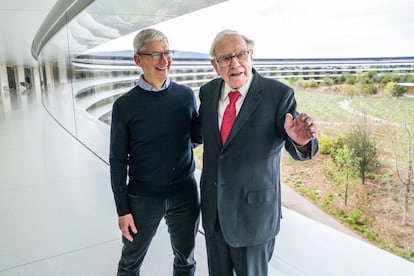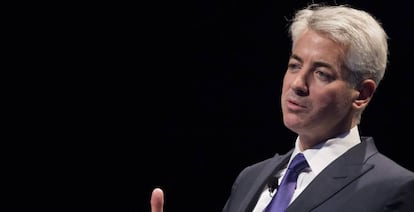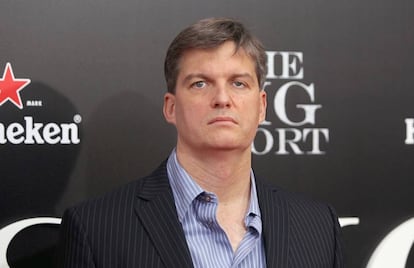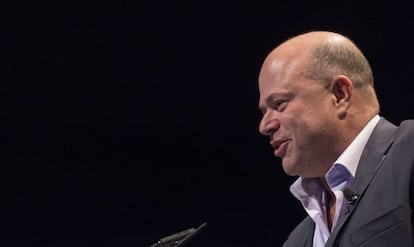From Buffett to Soros, the five most profitable stock market plays in history
Big investors often take advantage of crises to place their most lucrative bets

Michael Burry of The Big Short fame is back in the headlines this summer for gambling more than 90% of his portfolio on a market downturn. The eccentric hedge fund manager, who accurately predicted the 2008 subprime mortgage crisis, is the only Wall Street figure to have a film made in his honor; the 2015 movie by Adam McKay chronicles how this former doctor struck gold by taking ultra-speculative positions against the U.S. mortgage derivatives market. When the housing market, based on high-risk subprime loans, collapsed in 2008, Burry became a millionaire. And a legend. He has now bet $1.6 billion on a US stock market crash. There’s no sign his bet will pay off so far, but investors everywhere are holding their breath.
Burry’s ‘short’ bet against the unbridled US mortgage industry of 2005-2007 earned him $100 million in three years. His gamble is now considered one of the great punts in stock market history. It was not only about getting rich in a short period of time, it was doing so by going against the establishment. Who wouldn’t want that? But Burry isn’t the only Wall Street wizard and his is not the only winning tactic.
Each of history’s most famous investors has had a golden moment, whether it was putting the British government in a bind, investing in banks when the sector appeared to be in freefall or covering themselves against the economic and financial crisis caused by the coronavirus pandemic. Soros, Ackman, Tepper, Burry and Buffett are so famous, their stories have turned them into celebrities.
1. Buffett and his love affair with Apple

Born in Omaha, US, in 1930, Warren Buffett has been dubbed the world’s sharpest investor. He started from zero – well, not quite, as his father was a politician and owned a stock market firm – to become one of the richest men on the planet, with a fortune of $120 billion. The Omaha Oracle built up his capital through his company Berkshire Hathaway, whose investments have been spread across a wide range of businesses over six decades.
Buffett, 93, has shares in Coca Cola, Bank of America and Kraft Heinz. But if there is one investment that stands out above all others, it is Apple. He first bought shares in the iPhone firm in 2016, relatively recently, but the performance of the stock has been so spectacular that it now represents 51% of his entire portfolio, something he has never experienced before.
Buffett had always stressed the importance of diversifying investments. Until his windfall with Apple, that is. His conglomerate Berkshire Hathaway bought securities in 2016 worth $1 billion. And then it kept buying. And the stock kept going up. In total, the group is estimated to have invested $36.3 billion in the Apple brand, now worth $194 billion, thanks to an average revaluation of almost 400%. In absolute terms, this represents an enormous $158 billion in just over six years, of which $40 billion belongs to Buffett. Never before has anyone earned so much from one investment in such a short time.
2. Bill Ackman: a hedge fund that vaccinated against Covid-19

New Yorker William Ackman, 57, belongs to a very different breed of investor. He studied art at Harvard, where he later earned a master’s degree in business. Although he started out in a conventional asset management firm focused on stock market investments, he soon became more attracted to the world of hedge funds. The domain of experienced investors and professional traders, this type of vehicle allows for a huge degree of flexibility: investors can take on debt, they can bet everything on one asset, and they can take short positions in order to profit from the devaluation of an asset.
After a brilliant career, Bill Ackman created his own hedge fund, Pershing Square Capital Management, in 2004. Starting with an initial capital of $54 million, it now manages assets worth almost $20 billion. The activity of a hedge fund manager is very different from that of a conventional investment manager. They often take positions in a company to act from within and encourage a change of direction or facilitate a merger. And when they bet on the devaluation of stock, they may – controversially – launch campaigns to undermine the company in question by highlighting its flaws. This is what Ackman’s hedge fund did with Herbalife, accusing it of running a pyramid sales scheme. However, the $50 million spent on a public relations campaign against the company proved ultimately unrewarding as its share price continued to rise four years after the onslaught began, and he was forced to abandon his strategy.
But betting on the devaluation of stock did work out for him in 2020, when the global coronavirus pandemic broke out. In February of that year, the virus prompted massive lockdowns in China, and Ackman immediately understood that these unforeseen circumstances would trigger a sharp correction in stock markets around the world. “Hell is coming,” he told his employees. To protect himself, he took out a type of financial derivative known as credit protection. These are options linked to the perceived creditworthiness of a company. If the company’s creditworthiness takes a turn for the worse, whoever has them makes money.
According to information published by The Wall Street Journal, Ackman sunk $27 million into these credit protection derivatives and, thanks to the sharp fall in the stock market, earned $2.6 billion in a few months*. While half of humanity was living in lockdown and anguish, Ackman was watching his gamble pay off from the luxury of his New York penthouse, overlooking Central Park.
3. The bet that brought Britain to its knees
Born into a Budapest family of non-practicing Jews, György Schwartz, better known as George Soros, 93, miraculously survived the Nazi occupation of Hungary and moved to the U.K. By the 1970s, he had become one of Britain’s most famous hedge fund managers, and his boldest move brought the Bank of England to its knees in 1992. Boasting a fortune of $40 billion, he has become synonymous for many with the shadowy power behind global geopolitics while falling foul of the far right for donating $32 billion of his fortune to the Open Society Foundation, which promotes democracy around the world.
But the man who spotted how to crack the UK’s monetary policy and make a massive profit was, in fact, not Soros at all, but his wingman, Stanley Druckenmiller, the best macro operator in history. It was he who saw that the country’s hesitant entry into the European Exchange Rate Mechanism (ERM) could be exploited. The ERM obliged the currencies of the countries in the European Union to fluctuate within limits bound to the German mark. The pound sterling could not move more than 6% against it.
Druckenmiller was quick to predict trouble ahead for the pound. Prices in Germany were soaring after the country’s reunification. To control inflation, Berlin raised interest rates sharply. That boosted the mark against the pound. To counteract this, the UK also had to raise rates – despite a recession – and buy its own currency on the open market. After a few quarters, the situation looked untenable. Druckenmiller smelled blood, alerted Soros and they “went all in,” in Soros’ own words on a trade of a lifetime.
Soros’ fund, Quantum Funds, started borrowing money to take short positions against sterling, betting in total more than $4 billion. In a desperate attempt to rescue the situation, the Bank of England raised rates to 12%, but its credibility by then had been shredded and in the end the UK had to give in and exit the ERM. Meanwhile, Soros and Druckenmiller had pocketed $1 billion.
4. Michael Burry: the B-side of US mortgages

A former doctor doing shift work at a hospital, US investor Michael Burry, 52, was an outsider in the financial world. He also suffered from Asperger’s syndrome, an autism spectrum disorder that perhaps provided him with an unusual insight into the crazy workings of the mortgage market in 2003.
The Big Short explains perfectly the events leading up to the property crash and how Burry benefited. People with no stable job bought houses with 100% financing, putting them 100% in debt for the cost of their home. Another mortgage was taken out on that mortgage. And then another on that. And then those securities were packaged and marketed to investors carrying the highest credit rating, even though they were junk.
Burry realized this and managed to sign tailor-made contracts with Goldman Sachs: if the subprime market crashed, he would make a lot of money. It didn’t happen in a year. Nor in two. The investor had to keep paying and paying for those contracts as he watched his Scion Capital fund steadily lose money. Then came the crash. In the end, his strategy brought him a return of 489% between 2000 and 2008, compared to 3% for the US stock market over the same period. Burry earned $100 million.
Burry was not the only one to cash in. Kyle Bass, with his Hayman Capital fund, also bet against junk mortgages packaged and resold as a financial product known as CDOs – Collateral Debt Obligation. In his case, he played the game from the heart of Wall Street, which allowed the hedge fund’s total gains from this strategy alone to amount to $4 billion.
5. David Tepper: buying banks in a broken sector

US hedge fund tycoon David Tepper, 65, was the second son of a modest Jewish family from Pennsylvania. His mother was a teacher and his father an accountant. After earning an MBA, he began working in the investment world, first at Goldman Sachs, then creating his own hedge fund, Appaloosa Management, at the age of 35.
As has happened with most major investors, his golden moment came by swimming against the tide. After the collapse of Lehman Brothers in 2008 and the bailout of other financial institutions, there was a mass exodus from bank stocks. Traders had had their fingers burned. Tepper saw that there was a lot of irrational thought behind the tumbling stock prices and, in January 2009, he started buying Citigroup and Bank of America shares at low cost. In that year, prices quadrupled, and Appaloosa generated a return of 133%. Tepper made $7 billion for his investors.
Tepper’s story is also worth a movie. He left Goldman Sachs when he discovered that his boss, Jon Corzine, would not promote him to partner. On becoming a multi-millionaire, Tepper ended up buying his former boss’s house in the Hamptons, which he tore down. He then built himself one twice as big, to prove that “there was still some justice left in the world,” as he put it.
Sign up for our weekly newsletter to get more English-language news coverage from EL PAÍS USA Edition
Tu suscripción se está usando en otro dispositivo
¿Quieres añadir otro usuario a tu suscripción?
Si continúas leyendo en este dispositivo, no se podrá leer en el otro.
FlechaTu suscripción se está usando en otro dispositivo y solo puedes acceder a EL PAÍS desde un dispositivo a la vez.
Si quieres compartir tu cuenta, cambia tu suscripción a la modalidad Premium, así podrás añadir otro usuario. Cada uno accederá con su propia cuenta de email, lo que os permitirá personalizar vuestra experiencia en EL PAÍS.
¿Tienes una suscripción de empresa? Accede aquí para contratar más cuentas.
En el caso de no saber quién está usando tu cuenta, te recomendamos cambiar tu contraseña aquí.
Si decides continuar compartiendo tu cuenta, este mensaje se mostrará en tu dispositivo y en el de la otra persona que está usando tu cuenta de forma indefinida, afectando a tu experiencia de lectura. Puedes consultar aquí los términos y condiciones de la suscripción digital.
More information
Archived In
Últimas noticias
Most viewed
- Sinaloa Cartel war is taking its toll on Los Chapitos
- Oona Chaplin: ‘I told James Cameron that I was living in a treehouse and starting a permaculture project with a friend’
- Reinhard Genzel, Nobel laureate in physics: ‘One-minute videos will never give you the truth’
- Why the price of coffee has skyrocketed: from Brazilian plantations to specialty coffee houses
- Silver prices are going crazy: This is what’s fueling the rally










































